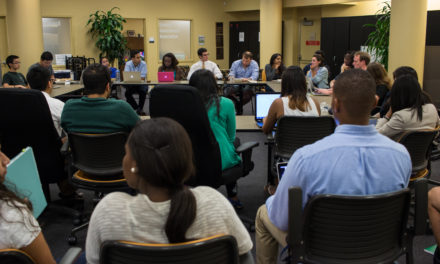Shoulders slump behind a row of open MacBooks. Students’ eyes dart up and down above the Apple logo on their metallic covers.
It’s a question with which professors all across campus are grappling. Should they let us use our laptops in class? This seemingly insignificant policy dilemma can have a profound effect on the classroom environment.
The case for both sides is relatively obvious. On the one hand, the temptation for distraction is high when students are allowed to use electronics in class. On the other hand, many students find a handy learning portal in their laptop sidekicks. At the end of the day, every student and every professor has his or her own preference and every classroom environment has its own parameters. We understand a professor’s inclination to completely ban laptop usage in class, but we hope that he or she provides enough wiggle room for students who are legitimately superior learners with their laptops.
Granted, the scientific studies regarding the subject do overwhelmingly lean to the side of pen-and-paper note taking. Cornell University found in 2003 that students performed better on post-lecture quizzes when they put their laptops to the side. Princeton University and University of California, Los Angeles found that imperfect note taking with a pencil actually induced more synthesis, while zombie typing led to transcription without thinking. And we understand that much of an undergraduate education should not be about memorizing facts, but rather about learning how to learn. Sometimes, students ought to trust that their professors who don’t – or do – allow laptops in class have their students’ intellectual development in mind.
But scientific study does not always encapsulate the variation in human experience, and Emory students often understand their learning styles well enough to know whether they learn better with or without their digital assistants. As a middle ground, the determined classroom policy does not have to be one way or the other.
The Center for Research on Learning and Teaching (CRLT) found that laptops can be an effective tool for learning if the faculty prepares for laptop usage rather than simply allowing it. More professors on campus are simply asking that all laptop users sit at the front of the classroom or off to the side. Some permit laptop usage on certain days, perhaps those that are lecture-based, and ban them on others, such as discussion-led sessions. Others don’t allow laptops but permit their usage for students with disabilities, and for those who make a compelling case for their machines and pledge to focus on classroom material.
While we concede that there are students who open up their laptops and are sucked into a browsing marathon or chat machine, we also need to acknowledge the spectrum of learning styles on this campus.
Emory professors could get the best of both worlds by simply providing some circumstantial leeway for those students itching to use their machines for actual learning purposes. Likewise, Emory students could benefit from giving their professors’ varying teaching styles a chance. No institution has completely untangled the dynamic between learning and technology. In Emory’s attempts to figure it out, we need to provide academic environments that allow all students to learn at their highest potential but not at the expense of the overall classroom atmosphere.
The above staff editorial represents the majority opinion of the Wheel‘s editorial board.
The Emory Wheel was founded in 1919 and is currently the only independent, student-run newspaper of Emory University. The Wheel publishes weekly on Wednesdays during the academic year, except during University holidays and scheduled publication intermissions.
The Wheel is financially and editorially independent from the University. All of its content is generated by the Wheel’s more than 100 student staff members and contributing writers, and its printing costs are covered by profits from self-generated advertising sales.





